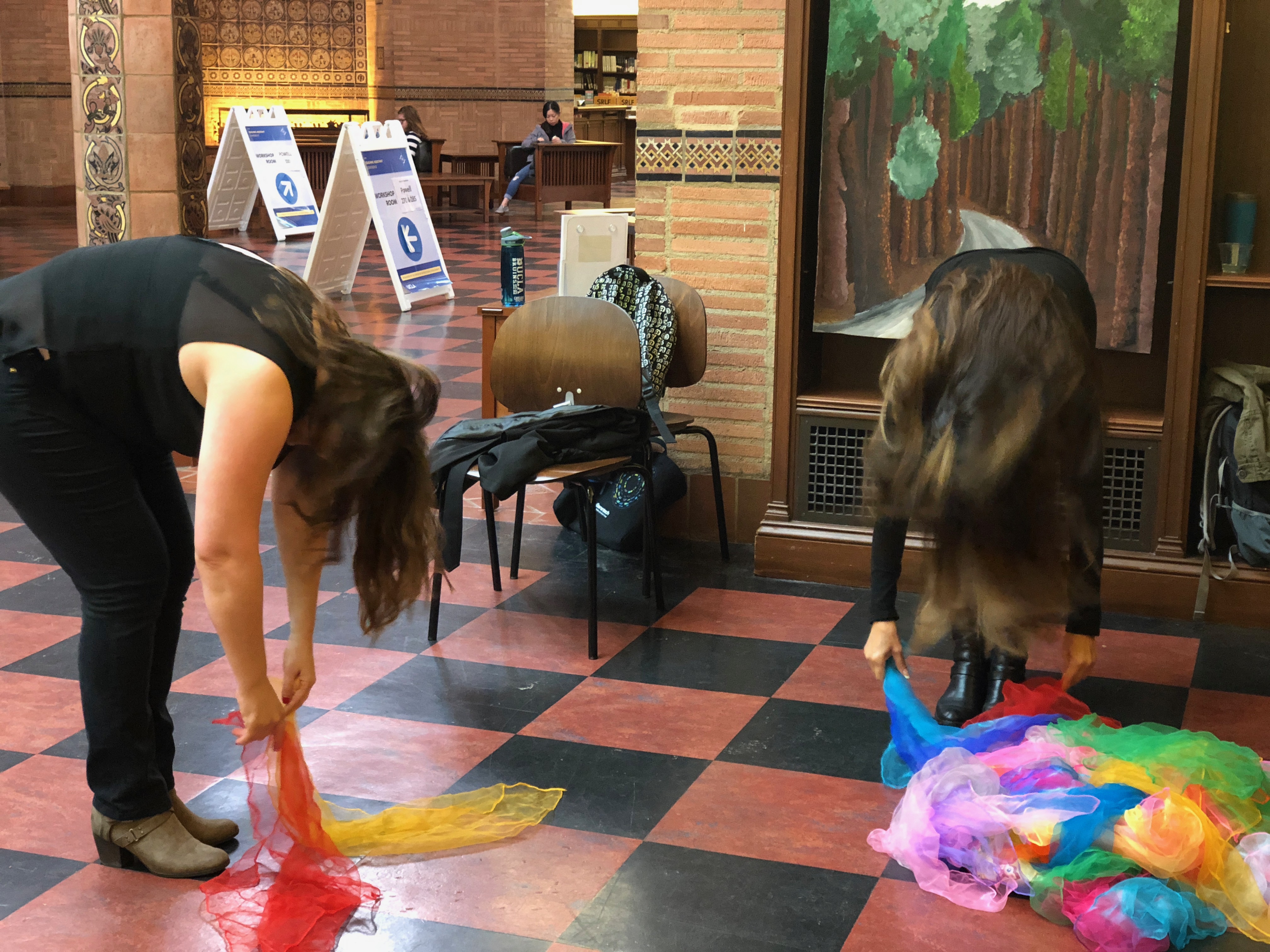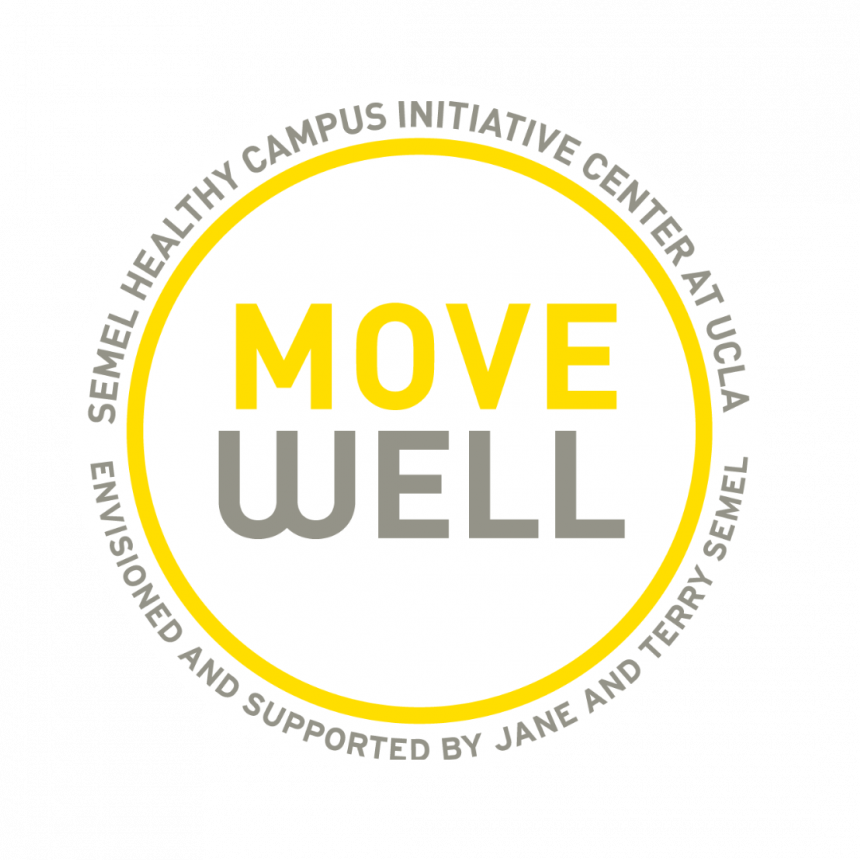Movement Breaks: A Colorful Adventure
Hello, Bruin Movers and Shakers! Ever felt like you just need a break during class when the lecture is droning on and your body is getting lethargic? Ever just wanted to get up for a quick second to get the blood moving through your body? Well we have another amazing example to show you!
Taking a “movement break” means moving in any way you like for at least a minute (could be for longer) to get your body grooving and to get the blood pumping!
Last year, we talked to the wonderful Dr. Elginer, faculty from UCLA Fielding School of Public Health, to get the inside scoop on how she incorporates movement breaks into her class to combat the effects of long term sitting. Now, we had the chance to speak with Elisabeth Nails, Graduate Student Researcher (GSR) for the MoveWell pod, to get her take on how to engage in movement breaks!
Tiffany Hu (TH): How did you come up with the idea of using scarves in your movement breaks?
Elisabeth Nails (EN): I learned about dance scarves through UCLA’s Center for Arts and Healing. I took a workshop with them and one of the facilitators introduced them in an assembly room full of adults at 9am. It was a bit stiff at first, but suddenly everyone was laughing and connecting and moving and all of the self consciousness dropped; people were just together having an experience, while having fun and moving.
TH: How did you first start incorporating movement breaks into your life?
EN: As an undergrad, I was a theatre major. I’ve directed many plays, so I’m always looking for different ways to warm up while building group energy. I also try to bring arts into everything I do, because the arts can do things that other things can’t. For the dance scarves, there’s a connection developed, even between strangers, derived from this feeling of “I see you” and “you see me” as we move together. The social and emotional benefits of that may seem really simple, but that can’t be beat!
TH: Have you done other kinds of movement breaks? How do you think using scarves is different than “typical” movement breaks (e.g. choreographed movements)?
EN: I appreciate any and all breaks, but for me, because I’m not trained as a dancer, I do not have that skill set as a facilitator; I want to bring something else to the table. I think that [movement breaks are] something anyone can do; the dance scarves take off the pressure of having to be a “cool mover” and help people feel confident in how your body moves. There’s something about [the scarves and their] simple structure that adds a layer of delight and freeing feeling.

“We need to grow a culture where we allow for moments where we completely shift gears to foster a culture of collaboration and listening.”
TH: How do you think movement breaks have enhanced your life? Have you seen the difference they make in other people’s lives (for example, a “change in the air”)?
EN: I’ve recently changed from being a staff member to a grad student and I realized how sedentary the student life is. I’ve been forcing myself to do my own fit breaks (like 30 second dance parties) which are super fast, but research backs it up that holding certain poses or doing certain movements reduces cortisol levels. I also think that we can’t ask people to sit for so many hours and ask them to be their best, their most creative, and engaged and open self.
TH: What advice would you give for professors or students who want to incorporate movement breaks in either their classes or their lives?
EN: I completely understand hesitation to shift the culture. It’s a vulnerable thing to put yourself out there and go: “Okay everybody we’re gonna break now and move.” The MoveWell pod is making a resource page for the variety of movement breaks with videos that can help you lead. You could also ask students to form a small committee who would be interested in leading these as well as create a class playlist. If you (the instructor) just create the space, then other people can come and fill it in. It’s also important to consider differently abled people and to always make room for that. It is important to be as inclusive as possible with the language, as not everyone can stand and not everyone can move in the same way. So make sure to offer multiple ways for people to participate!
TH: What’s your favorite part about doing fit breaks?
EN: Honestly, I love how at the end, there’s this slight shift and there’s this brightness in people’s eyes. It’s so subtle, but to me, it is so joyful to see! I hope to see more people embrace it, even just a trial, as it will create a shift!
We hope you all are as excited about these movement breaks as we are! Now that we gave you all the inside scoop on these movement breaks, for undergraduates and graduates, would you want them incorporated in your classes? Share your opinions in the comments and let your professors know as well!
As always, keep moving, my Bruin Movers and Shakers!
Tiffany Hu is an undergraduate student at UCLA majoring in Microbiology, Immunology, and Molecular Genetics. She is a blogger for Move Well of the UCLA Healthy Campus Initiative. She is the Assistant Commissioner of the Student Wellness Commission. Tiffany is also the Special Projects and Alumni Coordinator of the UCLA Care Extender Internship.







